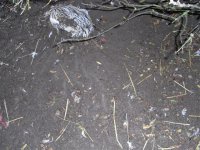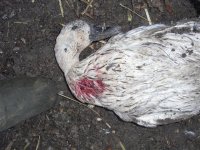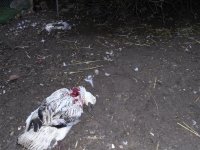Tim
Administrator
...but I feel they are important to show as part of the evidence...
Sadly, over night I lost 4 adult Abacot Ranger ducks to an unknown predator (suspected Fox, Mink, Stoat or Weasel).
They were behind an electric fence (tape) and chicken wire fence that is 6ft high in our garden run (only used at night time to allow the ducks to stay out and keep the ducks safe from the fox). There are no signs of digging or forced entry.
3 out of the 4 ducks were buried in the run, 2 drakes had their heads removed - these may also be buried somewhere in the run, I didn't have time to look for them under the bushes this morning when I left at 6am.
1 duck had most feathers removed from her neck and the other had just a very small area ripped out on the front of her neck to get to the jugular - a small slot that would fit about 3 fingers.
The bodies were still warm so I suspect this happened at first light.
Below are some photos of the buried ducks and the damage done to the 2 ducks. In one of the photos, you can see the scrape marks on the soil where it has scraped the top soil around the duck.
Since the bite to the front of the neck is so small on the one duck and no bodies were taken, and there is an electric tape around the run, I'm not ruling out a fox ...but whatever it is I'm sure it will be back.
I have not heard of Stoats / Weasels attacking such a large bird - Guinea Fowl size is about the largest I have heard of and I know foxes will bury their prey - but leaving them all behind?
For the last month, there has been an absence of rabbits in the field. There are normally many young rabbits hopping around at this time of year. I have also 'lost' some duck eggs from the run in the last 2 weeks but this could be children...
Does anyone have any more ideas on this? I plan to set a cage rabbit live catch trap tonight and keep a watch for foxes but I haven't had to deal with Mink before so I don't know if this is their typical behaviour or not.




Sorry for the awful photos but I felt they were important to show and might be crutial to identifying this predator.
Tim
